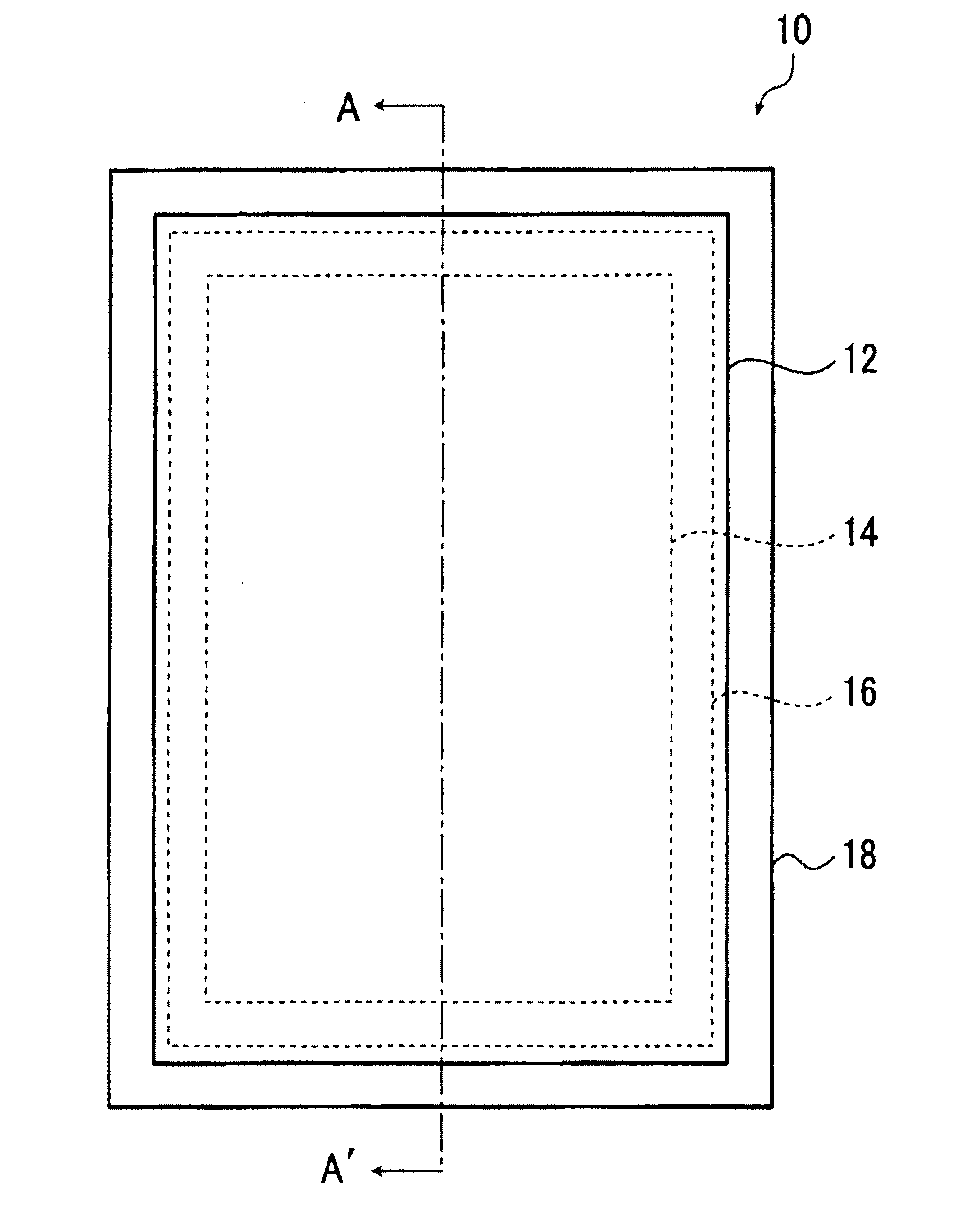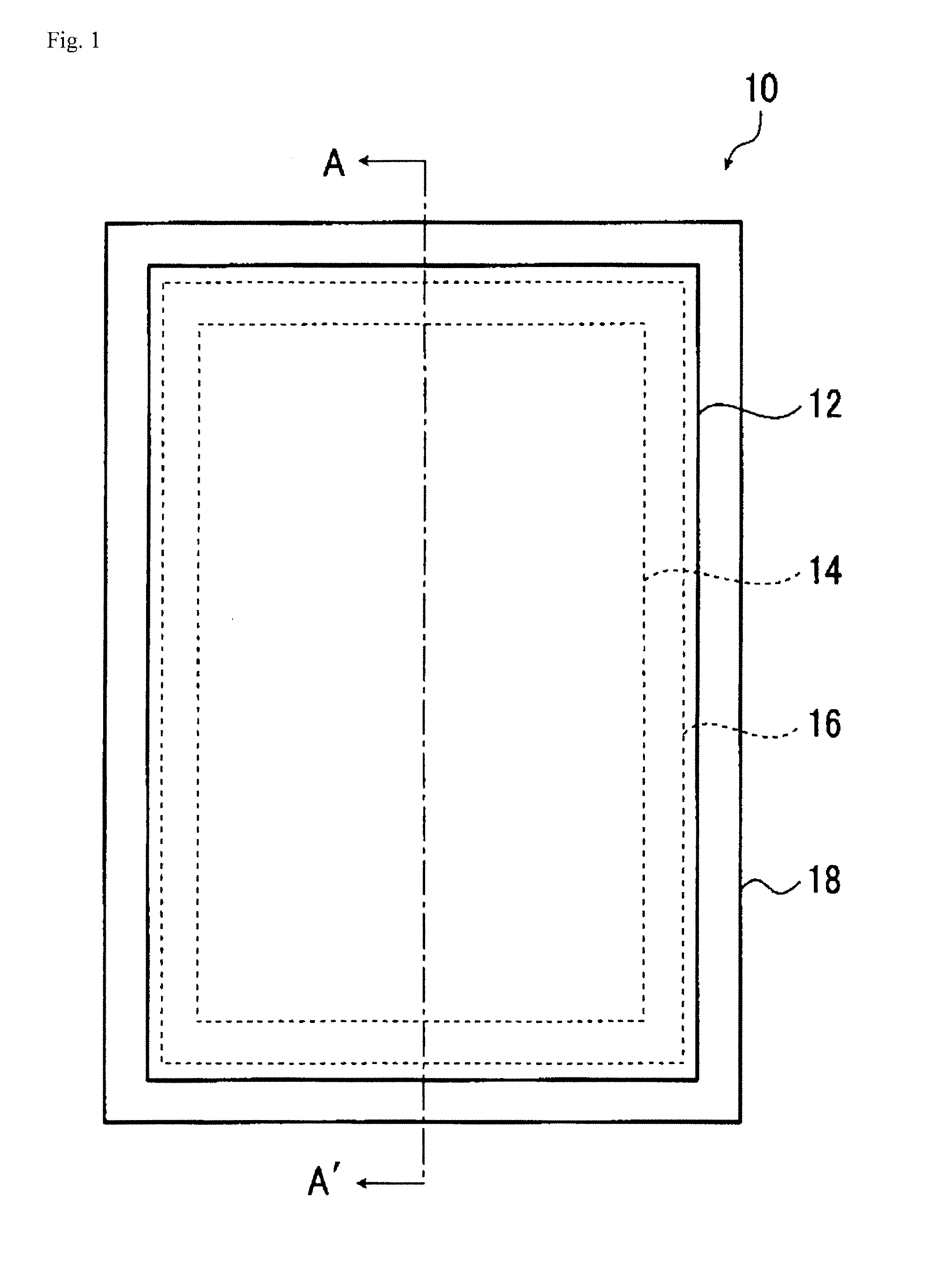Glass laminate, display panel with support, method for producing glass laminate and method for manufacturing display panel with support
a technology of glass substrate and support, which is applied in the direction of electrical apparatus construction details, instruments, chemistry apparatus and processes, etc., can solve the problems of glass substrate not being processed in current production lines, glass substrate thinning becoming important problems, and fine scratches on the surface of glass substrate, etc., to suppress the occurrence of glass defects, suppress the generation of gas, and easily separate closely contacted thin glass substrate
- Summary
- Abstract
- Description
- Claims
- Application Information
AI Technical Summary
Benefits of technology
Problems solved by technology
Method used
Image
Examples
example 1
[0238]About the same glass laminate as the glass laminate according to the embodiment 1 described with reference to the aforementioned FIG. 1 and FIG. 2 was produced by the following method. A difference from the embodiment 1 lies only in sizes of the thin glass substrate and the supporting glass substrate. In the glass laminate according to the embodiment 1, the thin glass substrate 12 is smaller in main surface area than the supporting glass substrate 18 but, in the glass laminate to be produced in Example 1, the sizes of both glass substrates are the same.
[0239]First, a supporting glass substrate having a length of 720 mm, a width of 600 mm, a thickness of 0.4 mm, and a linear expansion coefficient of 38×10−7 / ° C. (manufactured by Asahi Glass Co., Ltd., AN100) was subjected to cleaning with pure water and UV cleaning to clean the surface.
[0240]Next, a mixture of 100 parts by mass of a non-solvent addition reaction-type silicone for release paper (manufactured by Shin-Etsu Silicon...
example 2
[0251]Two sheets of a glass laminate were produced by performing the same operations as in Example 1 except that a thermoplastic polyimide resin (manufactured by Mitsui Chemicals Inc., AURUM PLC 450C (5% mass loss temperature upon heating=570° C.)) was used and, after melting, the outer frame layer was formed by an extrusion dispense method. Then, a “glass laminate B-1” not subjected to the heating treatment and a “glass laminate B-2” subjected to the heating treatment were obtained in a similar manner to the case of Example 1. In this regard, the glass laminate B was separately heated from room temperature to 450° C. under a high vacuum (1.0×10−5 Pa) but no gas was generated from the glass laminate B. In the glass laminate B-1 and the glass laminate B-2 obtained, the thin glass substrate had been in close contact with the silicone resin layer without having air bubbles and was also satisfactory in smoothness without any convex defect.
[0252]Moreover, when the above peeling test 1 wa...
example 3
[0253]Example 3 is the same as Example 1 except that a supporting glass substrate, a resin layer, an outer frame layer, and a thin glass substrate different in kind, size, thickness, etc. were used.
[0254]As the supporting glass substrate, a glass substrate having a length of 720 mm, a width of 600 mm, a thickness of 0.6 mm, and a linear expansion coefficient of 38×10−7 / ° C. (manufactured by Asahi Glass Co., Ltd., AN100) was used.
[0255]Moreover, as a resin for forming the resin layer, a linear polyorganosiloxane having a vinyl group in both terminal ends (manufactured by Arakawa Chemical Industries, Ltd., trade name “8500”) and a methyl hydrogen polysiloxane having a hydrosilyl group in the molecule (manufactured by Arakawa Chemical Industries, Ltd., trade name “12031”) were used. Then, they were mixed with a platinum-based catalyst (manufactured by Arakawa Chemical Industries, Ltd., trade name “CAT12070”) to prepare a mixture, which was applied in a size of a length of 700 mm and a ...
PUM
| Property | Measurement | Unit |
|---|---|---|
| mass loss temperature | aaaaa | aaaaa |
| width | aaaaa | aaaaa |
| temperature | aaaaa | aaaaa |
Abstract
Description
Claims
Application Information
 Login to View More
Login to View More - R&D
- Intellectual Property
- Life Sciences
- Materials
- Tech Scout
- Unparalleled Data Quality
- Higher Quality Content
- 60% Fewer Hallucinations
Browse by: Latest US Patents, China's latest patents, Technical Efficacy Thesaurus, Application Domain, Technology Topic, Popular Technical Reports.
© 2025 PatSnap. All rights reserved.Legal|Privacy policy|Modern Slavery Act Transparency Statement|Sitemap|About US| Contact US: help@patsnap.com



